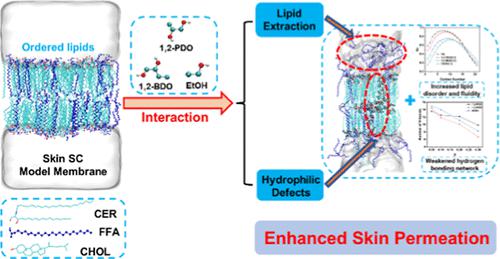Our official English website, www.x-mol.net, welcomes your
feedback! (Note: you will need to create a separate account there.)
Unraveling the Molecular Mechanisms of Alcohol-Mediated Skin Permeation Enhancement: Insights from Molecular Dynamics Simulations
Langmuir ( IF 3.7 ) Pub Date : 2023-12-19 , DOI: 10.1021/acs.langmuir.3c02809 Shiqiang Cheng 1 , Kangfu Zhou 2 , Feifei Wang 2, 3 , Zhicheng Ye 1 , Chuanjun Ye 2 , Cheng Lian 1 , Yazhuo Shang 1 , Honglai Liu 1
Langmuir ( IF 3.7 ) Pub Date : 2023-12-19 , DOI: 10.1021/acs.langmuir.3c02809 Shiqiang Cheng 1 , Kangfu Zhou 2 , Feifei Wang 2, 3 , Zhicheng Ye 1 , Chuanjun Ye 2 , Cheng Lian 1 , Yazhuo Shang 1 , Honglai Liu 1
Affiliation

|
The application of alcohols as permeation enhancers in pharmaceutical and cosmetic formulations has attracted considerable attention, owing to their skin permeation-enhancing effect. Nonetheless, the elucidation of the fundamental mechanisms underlying the skin permeation-enhancing effect remains elusive. In this study, molecular dynamics (MD) simulations were employed to investigate the effect of 1,2-propanediol (1,2-PDO), 1,2-butanediol (1,2-BDO), and ethanol (EtOH) on the stratum corneum (SC) model membrane. The results showed that the effect of alcohols on the SC model membrane displayed a concentration-dependent nature. The alcohols can interact with SC lipids and exhibit a remarkable ability to selectively extract free fatty acid (FFA) molecules from the SC model membrane and make the SC looser. Meanwhile, 1,2-BDO and EtOH can penetrate into SC lipid bilayers at higher concentrations, leading to the formation of continuous hydrophilic defects in SC. The FFA extraction and the formation of continuous hydrophilic defects induced ceramide (CER) tail chains to become more disordered and fluid and also weakened the hydrogen bonding (H-bonding) network among SC lipids. Both the FFA extraction and the continuous hydrophilic defect formation endowed alcohols with the permeation-enhancing effect. The constrained simulations revealed that the free energy barriers decreased for the permeation of the hydrophilic model molecule (COL) across the SC model membranes containing alcohols, particularly for 1,2-BDO and EtOH. The possible permeation-enhancing mechanisms of alcohols were proposed correspondingly. This work not only provided a deep understanding of the transdermal permeation-enhancing behavior of alcohols at the molecular level but also provided necessary reference information for designing effective transdermal drug delivery systems in applications.
中文翻译:

揭示酒精介导的皮肤渗透增强的分子机制:分子动力学模拟的见解
由于其皮肤渗透增强作用,醇作为渗透促进剂在药物和化妆品配方中的应用引起了相当大的关注。尽管如此,对皮肤渗透增强作用的基本机制的阐明仍然难以捉摸。在这项研究中,采用分子动力学(MD)模拟来研究1,2-丙二醇(1,2-PDO)、1,2-丁二醇(1,2-BDO)和乙醇(EtOH)对角质层(SC)模型膜。结果表明,醇类对SC模型膜的影响表现出浓度依赖性。醇类可以与 SC 脂质相互作用,并表现出从 SC 模型膜上选择性提取游离脂肪酸 (FFA) 分子并使 SC 更加疏松的显着能力。同时,1,2-BDO和EtOH可以在较高浓度下渗透到SC脂质双层中,导致SC中形成连续的亲水缺陷。 FFA 提取和连续亲水缺陷的形成导致神经酰胺 (CER) 尾链变得更加无序和流动,同时也削弱了 SC 脂质之间的氢键 (H 键合) 网络。 FFA 萃取和连续亲水缺陷的形成都赋予醇类渗透增强作用。约束模拟表明,亲水模型分子 (COL) 穿过含有醇的 SC 模型膜渗透时,自由能垒降低,特别是 1,2-BDO 和 EtOH。相应地提出了醇可能的增渗机制。 这项工作不仅在分子水平上深入了解醇类的透皮渗透增强行为,而且为在应用中设计有效的透皮给药系统提供必要的参考信息。
更新日期:2023-12-19
中文翻译:

揭示酒精介导的皮肤渗透增强的分子机制:分子动力学模拟的见解
由于其皮肤渗透增强作用,醇作为渗透促进剂在药物和化妆品配方中的应用引起了相当大的关注。尽管如此,对皮肤渗透增强作用的基本机制的阐明仍然难以捉摸。在这项研究中,采用分子动力学(MD)模拟来研究1,2-丙二醇(1,2-PDO)、1,2-丁二醇(1,2-BDO)和乙醇(EtOH)对角质层(SC)模型膜。结果表明,醇类对SC模型膜的影响表现出浓度依赖性。醇类可以与 SC 脂质相互作用,并表现出从 SC 模型膜上选择性提取游离脂肪酸 (FFA) 分子并使 SC 更加疏松的显着能力。同时,1,2-BDO和EtOH可以在较高浓度下渗透到SC脂质双层中,导致SC中形成连续的亲水缺陷。 FFA 提取和连续亲水缺陷的形成导致神经酰胺 (CER) 尾链变得更加无序和流动,同时也削弱了 SC 脂质之间的氢键 (H 键合) 网络。 FFA 萃取和连续亲水缺陷的形成都赋予醇类渗透增强作用。约束模拟表明,亲水模型分子 (COL) 穿过含有醇的 SC 模型膜渗透时,自由能垒降低,特别是 1,2-BDO 和 EtOH。相应地提出了醇可能的增渗机制。 这项工作不仅在分子水平上深入了解醇类的透皮渗透增强行为,而且为在应用中设计有效的透皮给药系统提供必要的参考信息。


















































 京公网安备 11010802027423号
京公网安备 11010802027423号